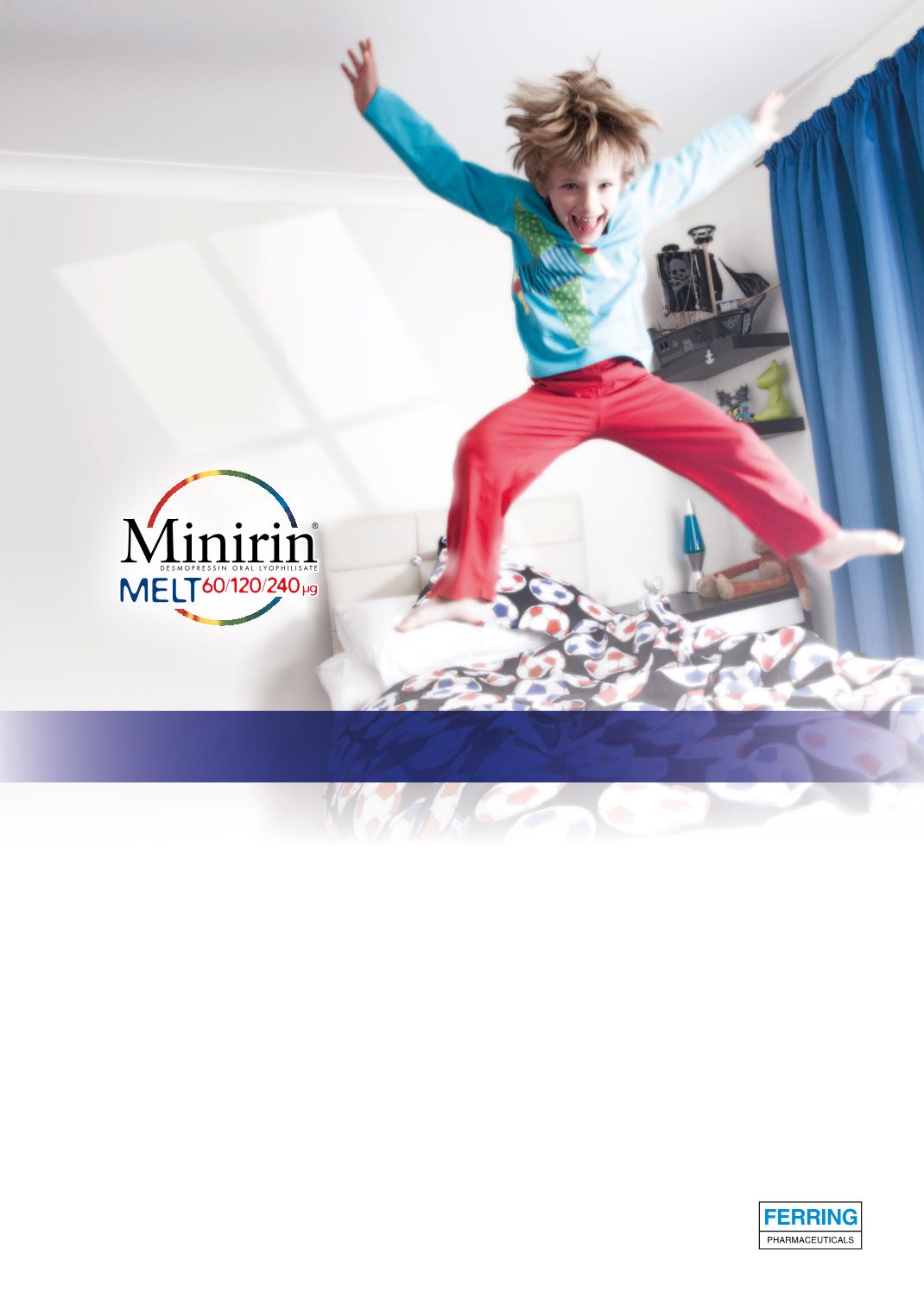

W H Y B E D W E T T I N G C A N
A N D S H O U L D B E T R E A T E D
Dry nights
mean good mornings
Higher levels of compliance and efficacy
with MINIRIN Melt
than MINIRIN tablet
1
Abbreviated Prescribing Information:
Prescribing information and indications
may vary from country to country. Contact the local Ferring representative
for country specific prescribing information.
Presentation:
MINIRIN
®
Melt is
presented as oral lyophilisates containing 60 μg,120 μg or 240 μg desmopressin.
The oral lyophilisates are white, round, and marked with one, two or three
drop shaped figures on one side for the strengths 60 μg, 120 μg and 240 μg
respectively. MINIRIN
®
Melt also contains gelatin, mannitol and citric acid,
anhydrous.
Indications
: Central Diabetes Insipidus; Primary Nocturnal Enuresis
in patients (from 5 years of age) with normal ability to concentrate urine; and
symptomatic treatment of Nocturia in adults, associated with nocturnal polyuria
(i.e. nocturnal urine production capacity exceeding bladder capacity).
Dosage
and method of administration:
Central diabetes insipidus: The normal daily
maintenance dose in adults and children is 60 μg – 120 μg administered
sublingual three times daily.
Primary nocturnal enuresis:
The recommended
dose is 120 μg – 240 μg administered sublingual at bedtime.
Nocturia:
The
recommended initial dose is 60 μg administered sublingual at bedtime. The
dose may be increased up to 120 μg and subsequently 240 μg by weekly
dose escalations. The initiation of treatment in elderly (over 65 years old) is not
recommended.
Contraindications:
Habitual or psychogenic polydipsia (resulting
in a urine production exceeding 40 ml/ kg/24 hours); A history of known or
suspected cardiac insufficiency and other conditions requiring treatment with
diuretics; Moderate and severe renal insufficiency (creatinine clearance below
50 ml/min); Known hyponatraemia; Syndrome of inappropriate ADH secretion;
Hypersensitivity to desmopressin or the excipients.
Warnings:
When used for
primary nocturnal enuresis and nocturia indications, the fluid intake must be
limited to a minimum from 1 hour before until 8 hours after administration.
Treatment without concomitant reduction of fluid intake may lead to water
retention and/or hyponatraemia with or without accompanying warning signs
and symptoms (headache, nausea/vomiting, weight gain, and, in severe cases,
convulsions).
Precautions:
Severe bladder dysfunction and outlet obstruction
should be considered before starting treatment.Elderly patients and patients with
low serum sodium levels may have an increased risk of hyponatraemia.Treatment
with desmopressin should be interrupted during acute intercurrent illnesses
characterised by fluid and/or electrolyte imbalance (such as systemic infections,
fever, gastroenteritis). Precautions to avoid hyponatraemia including careful
attention to fluid restriction and more frequent monitoring of serum sodium
must be taken in case of concomitant treatment with drugs, which are known
to induce SIADH, e.g. tricyclic antidepressants, selective serotonine reuptake
inhibitors, chlorpromazine and carbamazepine, case of concomitant treatment
with NSAIDs.
Side effects:
Primary nocturnal enuresis & diabetes insipidus:
Common: Headache, abdominal pain and nausea. Very rare: Hyponatraemia.
Nocturia:The most frequent during dose-titration: Headache, nausea, abdominal
pain, hyponatraemia, dizziness, and dry mouth. The most frequent in long-
term treatment: Headache, dizziness, peripheral oedema, micturition frequency,
nausea, and weight increase.
Legal category:
POM.
Date of preparation:
May
2005. Ferring International Center S.A. Chemin de la Vergognausaz 50, 1162
Saint-Prex, Switzerland.
Minurin no está autorizado en España para la indicación de nocturia.
Fichas técnicas disponibles en el stand.
SmPC available at the booth.
Date of preparation March 2017
MN/1072/2016/EMDEOd
Reference:
1.Juul KV
et al.
Eur J Pediatr 2013;172:1235-1242







